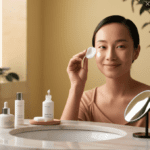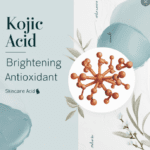Kojic acid is a popular skincare ingredient often praised for its ability to address uneven skin tone and hyperpigmentation. But what happens when it’s used over an extended period? While the ingredient offers remarkable benefits, its long-term use also raises important considerations. This article explores the findings of research, expert opinions from dermatologists, and real user experiences to provide a thorough understanding of kojic acid’s prolonged effects.
Research Insights on Kojic Acid
Studies have consistently demonstrated that kojic acid effectively lightens dark spots and pigmentation by reducing melanin production. When used consistently, it can provide noticeable improvements in skin tone, helping to address hyperpigmentation caused by sun damage, aging, or acne scars. These results have cemented its place as a key ingredient in many skincare products.
Safety Concerns and Risks
While kojic acid is generally considered safe at concentrations below 1%, long-term use requires caution due to its potential side effects. Here are the main risks associated with prolonged use:

Skin Irritation
Higher concentrations of kojic acid, particularly above 1%, are more likely to cause irritation. Symptoms may range from mild redness to severe rashes and inflammation. Those with sensitive skin are especially prone to these effects, and regular monitoring of the skin’s condition is advised.
Sun Sensitivity
Prolonged use of kojic acid can increase the skin’s sensitivity to sunlight. This heightened sun sensitivity raises the risk of sunburn and UV-induced skin damage. Experts strongly recommend the consistent use of sunscreen and protective measures while using kojic acid products to mitigate these risks.
Can Kojic Acid Cause Side Effects? How to Use It Safely
Rebound Hyperpigmentation
One significant drawback of long-term kojic acid use is the risk of rebound hyperpigmentation. Discontinuing the product may lead to the return of darkened areas, often undoing the progress achieved during use. This challenge can make it necessary for users to maintain ongoing treatments or adopt alternative measures to preserve results.
Potential Cytotoxic Effects
Some studies suggest that while kojic acid is safe under normal conditions, it may have cytotoxic effects at higher concentrations or when used excessively over time. Research indicates that this could impact certain cell types, including melanoma or other cancerous cells, though more investigation is needed to fully understand these implications.
What Dermatologists Say About Kojic Acid: Expert Insights
Dermatologists frequently recommend kojic acid for addressing dark spots, uneven pigmentation, and other discoloration issues. However, they emphasize the importance of using it correctly and cautiously when applied over extended periods. Here are their detailed perspectives:
Dr. Shereene Idriss: Balancing Benefits and Risks
Dr. Idriss highlights kojic acid’s standout feature: its ability to brighten skin and slow down the formation of hyperpigmentation.
“Kojic acid is a fantastic option for achieving a more uniform skin tone,” she notes.
However, she warns that irritation risks increase when concentrations exceed 1%. For long-term users, she advises keeping an eye out for redness or irritation and pairing kojic acid with soothing ingredients.
https://www.perplexity.ai/search/what-does-research-and-scienti-dzqbrR47RoKbYxGBksxpsA
Dr. Joshua Zeichner: The Sunscreen Imperative
Dr. Zeichner underscores the importance of sun protection when using kojic acid over time.
“While kojic acid is effective in lightening dark spots, it makes your skin more vulnerable to UV damage,” he explains 1.
He strongly recommends daily sunscreen use, especially for individuals using kojic acid as part of their regular routine.
Dr. Jennifer Chwalek: Effectiveness with Caution
According to Dr. Chwalek, kojic acid delivers measurable results in treating pigmentation, but the skin’s increased sensitivity to sunlight is a critical consideration 2 . She emphasizes the importance of limiting sun exposure and suggests using products that combine kojic acid with hydrating agents to minimize irritation during long-term use.
Dr. Kally Papantoniou: Monitoring and Moderation
Dr. Papantoniou advises users to adopt a cautious approach when incorporating kojic acid into their skincare. “Be vigilant for allergic reactions or irritation,” she advises 3 . For those with sensitive skin, she suggests using kojic acid in cycles or taking occasional breaks to reduce the likelihood of adverse reactions while still reaping its benefits.
Key Takeaways from Dermatologists
-
Limit kojic acid concentrations to 1% or lower for safer, long-term use.
-
Sunscreen is non-negotiable when using kojic acid, given its ability to heighten UV sensitivity.
-
Monitor your skin regularly for irritation or allergic reactions and adjust use as needed.
-
Pair kojic acid with hydrating or soothing products to mitigate potential dryness or sensitivity.
Real-Life Experiences: Users Weigh In on Long-Term Kojic Acid Use
The experiences of real users shed light on what to expect from kojic acid when used over months or years. While many report glowing results, others share challenges like irritation or the need for careful maintenance.
Maria Johnson: Visible Results with a Learning Curve
Maria used kojic acid consistently for six months and was thrilled to see her dark spots fade significantly 1 . However, she experienced initial irritation, including redness and dryness, which made her rethink how much she applied.
-
“I started using it every other day and paired it with a moisturizer,” she shared, which helped her achieve results without overwhelming her skin.
David Chen: A Balancing Act
David turned to kojic acid to tackle stubborn hyperpigmentation caused by acne scars. He saw improvements within a couple of months, but sun sensitivity quickly became a concern. 2 “I couldn’t leave the house without sunscreen,” he said. David found that balancing consistent use of kojic acid with diligent sun protection was key to seeing lasting results without compromising his skin health.
Samantha Lee: Rebound Hyperpigmentation Challenges
Samantha had glowing skin during her first few months of using kojic acid. However, when she stopped using it, she noticed her skin tone reverting to its previous unevenness. “It was frustrating to see my dark spots come back,” she admitted. 3 To manage this, Samantha decided to use kojic acid periodically instead of discontinuing it completely, allowing her to maintain her results without overexposure.
Emily Rodriguez: Success with Caution
As someone with sensitive skin, Emily approached kojic acid cautiously. While it lightened her acne scars effectively, she had to ensure she didn’t overuse it. 4 “I would get redness if I applied too much or too often,” she noted. Emily found that spacing out applications and using a gentle cleanser alongside kojic acid made a significant difference.
John Smith: Long-Term Maintenance
John discovered that using kojic acid consistently gave him a brighter complexion. However, to avoid irritation, he took breaks every few months. “Giving my skin a rest seemed to help keep it healthy while still enjoying the benefits of kojic acid,” he explained.
Key Takeaways from Users
-
Gradual introduction of kojic acid into your routine can minimize irritation.
-
Sunscreen is essential to protect against increased UV sensitivity.
-
Results often require ongoing use to maintain; discontinuation can lead to rebound hyperpigmentation.
-
Taking occasional breaks can help reduce the risks of overuse and irritation.
-

I’m a devoted organic skincare enthusiast, passionate about the natural, wholesome goodness that organic products bring to our skin.
Organic skincare isn’t just a hobby for me—it’s a lifestyle. Every product I use, recommend, and write about has been carefully chosen for its purity and effectiveness. Everything I write about is backed by scientific studies, dermatologists’ opinions, and user experiences.
I also excel at tackling skincare challenges with innovative, organic solutions.


